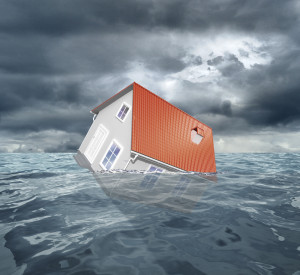Federal Flood Insurance policy increases are hitting homeowners hard

The program is currently $24 billion in the hole. An increasing number of severe storms over the past 10 years have left the program deep in debt.
On April 1st, the National Flood Insurance Program started issuing new rates on personal flood insurance policies and premiums are headed up for most homeowners
The Federal Emergency Management Agency (FEMA) is in charge of managing the program and claims the premium increases are necessary to get the program back on solid footing. The program is currently $24 billion in the hole. An increasing number of severe storms over the past 10 years have left the program deep in debt.
Homeowners are seeing rate increases that are hitting 25 percent in some cases, along with surcharges that can be up to $250 for a second home. A surcharge of $25 applies to owner-occupied houses. These types of premium increases are mainly affecting homeowners that live in high-risk flood plains, about 1 million households across the nation.
The biggest rate increases will hit vacation homes and older coastal properties that do not meet today’s flood safety code standards. While these homes are spread across the country, Tampa has one of the highest concentrations of these type homes in the country.
The rate increases will take affect at the homeowner’s next renewal. As government subsidies are phased out, rates will increase each year until the premium reaches the actual cost of insuring the house.
Hitting Homeowners Hard
Currently, there are 5.2 million homeowners that have flood insurance policies with the average annual premium running about $650 but in high-risk areas the cost is often considerably higher. This is putting pressure on low to moderate-income households.
There have been cases where homeowners have faced a tripling of their insurance premium. Disputes over why the program is in such debt have raged for years with government officials claiming the current rates are nowhere near the actual cost of insuring the property while unhappy homeowners feel the debt is due to excessive government spending and mismanagement of funds.
Experts from the Insurance Information Institute have said that:
“rates need to approximate risk and that rising sea levels and climate change will continue to increase risk and push premiums up in costal areas.”
The rate increases have started to affect home sales in coastal areas and as rates continue to go up every year real estate professionals are concerned coastal homes will be extremely difficult to sell.
What can you do?
Remember, a standard homeowners policy does not offer flood protection so if are in a flood prone area, a separate flood policy is a necessity.
Experts recommend calling your insurance agent and asking for the actuary rate for the home. Eventually, that is what your flood insurance premium will end up being. Do not be shocked at the number as most likely it will be much higher than what you are currently paying.
Raising your deductible should help. Residential deductible limits are being raised up to $10,000 from $5,000. If you can afford the deductible, raising it could result in your premium being 40 percent cheaper.
Upgrading your house, putting it on stilts or raising it up on bricks can also result in a discount on the premium increase. Unfortunately, this can be expensive, running in the neighborhood of $30,000 depending on the size of the house.
Experts recommend keeping a detailed inventory of your possessions in the event that the worst happens. It will help speed up the claims process and make sure you are fairly paid for your loss.
Finally, if the costs are just too much, considering moving out of the flood zone. Don’t wait though, as insurance rates continue to rise it may become harder and harder to sell your home.
